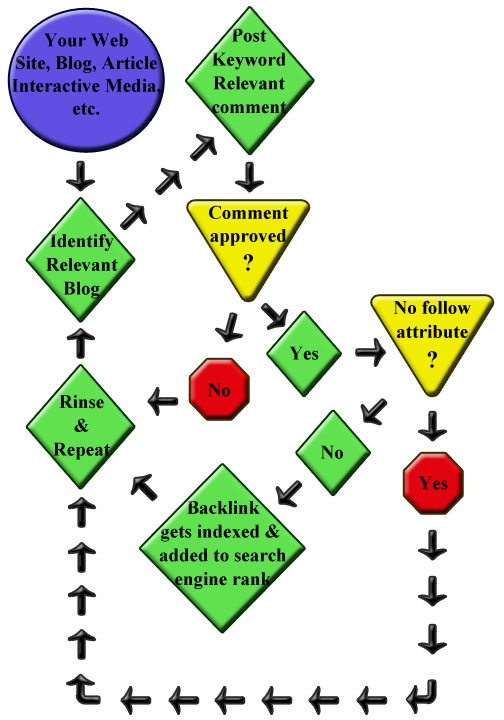- HubPages»
- Business and Employment»
- E-Commerce & How to Make Money Online»
- Search Engine Optimization
Backlinks: Creating & Posting Effective Backlinks
What are Backlinks & What's the Big Deal?
In your search for trying to improve your page ranking in the search engines to increase targeted traffic to your web site, vlog, blog, or article, you have had to learn about search engine optimization (SEO) and while learning how to make your web site, article, or blog search engine friendly, you may have come across the terms: inbound links (IBL) or backlinks (however you want to spell it and whatever you want to call them, inbound links, back-links, all mean the same thing). Back links are hyperlinks to the URL address of your web site, blog, or article that can direct (link) people to your page from other web sites, blogs, or articles.

Backlinks are not just good for increasing targeted traffic to your page from the wandering Internet surfer who just happens to come across and click on your link. Back links are good for helping the search engines determine how relevant your page is to the search topic. When the top search engine’s web crawler ranks your web site, article, vlog,or blog, one of the factors the web crawlers are looking for is backlinks, as they provide a link juice (data) that allows the web crawlers to analyze and rank your page. However, the web crawlers are not just looking for any backlinks, they are looking for quality, relative back links. So having back links on any and every website you can possibly place a link on is not how you want to go about placing your backlinks, if you want to improve your page ranking in the search engines, relative and quality with a bit of keyword optimization (what I like call ROQ (rock) solid) are the kind of back-links you need.
Where Do You Post Backlinks In Order For Search Engines to Consider Your Backlink as Relative and Quality?
There are several factors that top search engines consider when determining how relative and quality your backlink is, and all of them should help demonstrate a natural link juice flow. What is a natural link juice flow? In Google's eye as well as the other major search engines eyes, natural is really based on human nature, as the human audience is who they are trying to please with their search results. Thus a natural link juice flow would be link juice IBLs give the search engines web crawler that show human characteristics, such as a diversity of the factors the web crawlers use to determine relevance and quality. A lot of those factors will not only be expected search engine accommodations on your pages, but will be expected to be on the page that you are posting your backlink on.
One of the factors that search engine web bot crawlers look at is whether the web site, blog, or article you are posting a backlink on is a well known and quality web site, otherwise known as a “high authority.” A high authority web site will generally have a high page rank and a top level URL domain address such as .com, .edu, .org, or .gov. However, just because a web site has a high authority and page rank, the particular page you are posting your backlink on may not have a high search engine rank placement (SERP).
Want Back-links?
Being as .gov and .edu web sites are government and educational websites, even if you are a newbie to search engine optimization, I’m sure you can guess why a .gov and .edu would be the coveted sites to post backlinks on. A back link on a .gov or .edu page that is keyword relevant to the page your backlink points to can give you a massive increase in traffic, as well as give you a huge jump up in ranking on the search engine results simply because government and educational web sites get more traffic due to that “high authority” factor, and the public belief that .gov and .edu sites will have the best information.
How to Get IBLs
Since you can’t just go to any website and edit the HTML source code to add your backlink to that website, the only way you can add a back link is through comments, forums, etc., so here are some methods you can use to interact with other web sites, articles, or blogs to post your backlink on.
- Question answering sites
- Blog Commenting
- Forum Posting and Participation
- Social Bookmarking
- Social Networking Sites
- Video Marketing
- Article Marketing & Document Sharing
- Guest blog posting
- Press Releases
- Contacting the blogger, vlogger, or site owner with an offer they can't refuse
- If you are a merchant join an affiliate program and others will post IBLs for you.
Link Diversity Keeps Your Backlinks Natural and Search Engine Friendly
When the web crawler is calculating where your page should rank in the search engine results, a high authority site is 10 xs (10 times) more favorable to have a backlink on then a low authority site. However, having backlinks on high authority sites only can make your backlinks appear to be manipulated or to have an unnatural pattern to the web crawlers who are programmed to search for “natural patterns” in where and how often (the link velocity) you place backlinks. Natural patterns in link diversity and link velocity will show the web crawlers a balanced diversity and steady velocity, and can prevent the web crawlers from punishing you and diminishing your ranking for unnatural backlinking patterns.

Among the High Authority & Low Authority Blogs and Web Sites Hides the No follow Attribute
Having a backlink on a high authority site does not necessarily mean you are going to get a better search engine rank, especially if that blog or web site has a “no follow” attribute that commands the search engine’s web crawlers not to follow certain outbound links, making that particular backlink weightless to your page ranking. The no follow code was designed to cut down on the effectiveness of scammers and spammer’s backlinks to prevent certain types of search engine spam and manipulation. You can find the “no follow” code in the HTML source code of the website by right clicking your mouse and selecting view source then searching for a code that is similar to the example below.
Example: <a class="url" rel="external nofollow" href="http://www.example.com">Name</a>
Tip: If you use the firefox web browser you can easily find out if the site is no follow by highlighting (selecting) the text of a comment and the name of the person who left the comment, then right click your mouse and select view selection source. If you see a code similar to the example code above then that particular blog or website is a “no follow” web site.
Would you or have you ever used automated SEO tools?
Automated SEO Tools are Considered "Black Hat" SEO Tactics
There are also some SEO tools available such as Scrapebox and the Blog commenting ninja that will search through the Internet to find .edu and .gov, tell you which sites are no follow, and can even post intellectual comments for you. Granted a lot of SEO tools that search the internet for you are considered black hat seo tools, so before you commit to buy one make sure that it follows Google’s best practices, as you wouldn’t want to get a Google slap.
Remember, link diversity is important, so you will want to post backlinks to no follow sites just as much as you post to the sites that allow the search engines to follow your backlink. Even though the search engines won’t give you credit towards your rank on the search engines for backlinks on a no follow site, the backlink can still link people to your articles or web site to increase traffic, which is the goal after all.
Getting Started Backlinking
If you are new to the backlinking process then you are going to want to start out with leaving comments without backlinks, as you will first need to establish yourself as someone who is a worthy contributor to the online community, otherwise your comments will be deleted for sure and you will appear to be a spammer. Once you have established yourself as a worthy contributor (leaving at least 20 to 50 comments) you can then start leaving your backlinks with your comments.
While you are working on building your reputation in the online community you will notice that there will be some commenting forms that allow you to add your web site address (the URL address to your homepage). I have noticed that generally if you fill these out and have not established a good reputation in the online community your comment will get deleted.
Making Your Backlink
If you are new to all this search engine optimization talk, you may be wondering how to create backlinks in the first place. Making the actual backlink is actually pretty simple; once you find the site you are going to post your backlink on, just take the URL address (example: http://www.example.com ) of the page you want your backlink to point to and post it with your comment. There are some web sites, blogs, vlogs, or articles that will allow you to use HTML or BBC in your comment, which allows you to hide that ugly URL address in keywords you used in your comment. Those keywords that are hiding your URL address are generally called the "anchor text" and can help bring up your SERP for that particular keyword or keyword phrase. Although some of the sites that allow HTML require that you know HTML code in order to use that feature, so I have included a snip of HTML code that you can use just for that purpose, just fill in your URL address where it says “your URL address” and your keywords you want to use to link to your page where it says “keywords” and you will be good to go.
<a href="http://your URL address"> Keywords </a>
IBLs and Their Keyword Anchors Need to be Diverse
As I've said before, the major search engines web crawlers base your IBL quality and relevance on several factors which all happen to demonstrate a natural link juice flow. Since human nature is the top search engines idea of natural and we all know that human nature is diverse it not only makes since to use different relative keywords as anchors to provide that diverse human nature characteristic to the web bot crawlers, but also to your audience, who is diverse. Our diversity causes us all to do things a bit differently from one another, this is especially the case when it comes to the words we use. As they say: "To each, their own." Thus using different relative keywords as anchors instead of the same keyword anchor again and again will not only attract a diverse audience who is searching for the same information, but as you will be providing the major search engines with that diverse human characteristic they are looking for in your IBLs to appear natural, it will also provide a bit of link juice to boost your page's rank placement in different search terms containing the keyword which will help you get more traffic from several search terms instead of one.
Indexing Your Backlinks to Make Them Complete
Once your back link is posted, you will want to tell the search engines that you have new backlinks by telling the search engine to “ping” for links to your website so that the search engine can index them as fast as possible. Some web sites and blogs such as HubPages or WordPress will automatically ping the search engines every time new content or comments are added. If your website does not automatically ping the search engine, then you will need to go to Google Webmaster Tools and set your crawl rate settings under “Site Configuration > Settings.”
Now that you know of the ideal places to post backlinks, how important your backlink diversity is to your search engine rank and how to make backlinks, it’s time for you to get links posted to improve search engine ranking on your blog, vlog, article, or curated content. If you find that your backlinks are not sticking around because of moderation, on my profile you may find my upcoming article on making your backlinks sticky may help you out.
Copyright © 02/23/2012 by Page1 SEO tactics











